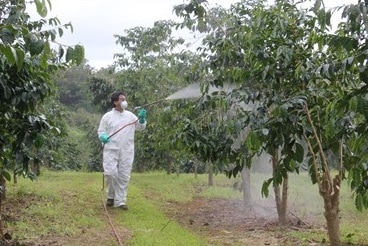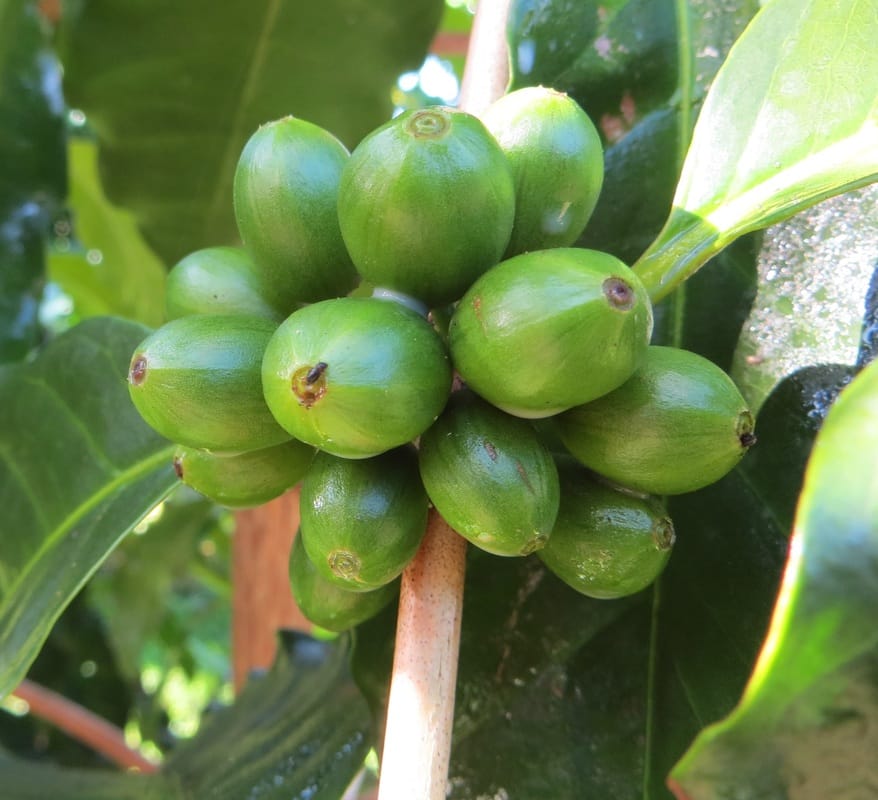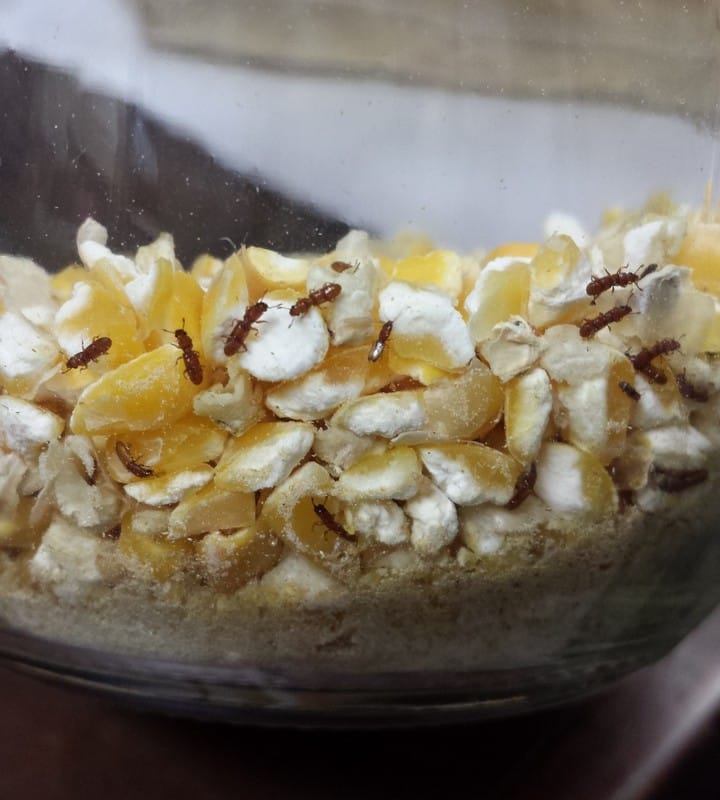Section III: CBB Control
The information below, is an excerpt from the "Recommendations for Coffee Berry Borer Integrated Pest Management in Hawai‘i 2020" document. The complete article can be downloaded here.
Do not use any pesticide not approved for use on coffee in Hawaii. Read and follow all label instructions before spraying Beauveria or any other pesticide or surfactant. The label is the law!
A. Spraying Beauveria
Beauveria bassiana strain GHA is the active fungal ingredient in the commercial B. bassiana products approved for use to spray and kill CBB on coffee grown in Hawaii (See list of licensed pesticides at https://hdoa.hawaii.gov/pi/pest/licensed-pesticides/):
- BotaniGard® ES (EPA Reg. No. 82074-1) – conventional
- Mycotrol® ESO (EPA Reg. No. 82074-1) – organic
1. How and at which rate do I apply Beauveria?
|
For tree applications:
|
2. When should I spray Beauveria?
|
3. How often should I spray?
|
Spray as often as justified by thresholds, sampling, and monitoring, or at least once a month. When sprayed, Beauveria spores (the active ingredient of BotaniGard® and Mycotrol® products) contact the insect’s cuticle or exoskeleton. The spores then adhere to the cuticle, germinate within 6–9 hours, and penetrate the cuticle within 24 hours. The insect is killed within 3–10 days depending on the dose of spores and the size of the insect. Optimal Beauveria growth occurs under conditions of above-74°F (23°C) temperature with constant high (96–100%) relative humidity for 2–3 days, but it declines quickly as temperature increases above 82°F (28°C) [14,15].
|
4. Should I spray the ground and in rock crevices around infested coffee trees?
|
Fallen or dropped cherry and raisin on the ground may contain live CBB [16], so spraying Beauveria on the ground may help to kill CBB when they emerge and are contacted by live spores. Field sanitation is still extremely important to reducing CBB populations on the farm and should be practiced. Follow the pesticide label for ground application.
|
5. Can I add other solutions to Beauveria sprays?
|
Other solutions can be mixed with Beauveria, but do not combine any pesticides not labeled for coffee. Fungicides may negatively affect Beauveria efficacy. Consult the compatibility chart created by the product’s exclusive distributor, BioWorks, Inc., prior to mixing pesticides with BotaniGard® and Mycotrol® products. This compatibility chart can be downloaded at https://www.bioworksinc.com/wp-content/uploads/products/shared/botanigard-es-tank-mix-compatibility.pdf, or visit http://www.bioworksinc.com for additional product information. Also, test any unique mixed solutions on a small scale for physical compatibility and phytotoxic effects.
|
6. Spraying tips for growers using Beauveria
|
B. Other Products Approved for Coffee
|
A list of pesticides and repellants approved for use on coffee can be found in Appendix D: Summary of Tested Insecticides and Repellents for CBB Control in Coffee. Determinations of efficacy on CBB as a result of scientific research are also provided.
As of March 2023, the effects of Delegate WG, a spinetoram product, has been published by Kawabata et. al. for use on coffee in Hawaii for the control of CBB. The article is found here. Effective use of this product is on CBB in the A/B position only. |
C. Biocontrol Agents
|
Research on the potential for importing biological control agents (e.g., parasitic wasps) against CBB is underway. Current biocontrol options using insect natural enemies, are limited to generalist predators, namely flat bark beetles (Cathartus quadricollis and Leptophloeus sp.).
|
|
Whether a product is organic or conventional, always read the label first, before transporting, storing, opening, mixing, applying and discarding. Personal protective equipment should be used at all times when applying and handling an organic or conventional pesticide.
Conduct your field sanitation and strip-pick first, then monitor, and then spray when warranted. |
Begin monitoring early in the season when berries are young as it is easier and best to control CBB during this time. Use the Revised Thirty Trees Sampling Method for CBB Monitoring - 2016 to determine when to spray.
Refer back to monitoring and record-keeping sections to understand how to identify the best timing and frequency of spraying for your farm. |
Flat bark beetles (FBB) are a local predator of CBB eggs, larvae and pupae. FBB are about twice the length, but about as wide as CBB. This allows FBB to enter into the hole made by CBB and feed on CBB young within the bean(s). Cathartus quadricollis and Leptophloeus sp. can be reared on a corn diet and enjoy supplemental bee pollen added to their rearing container as a food source. A weekly mist of water may be provided to FBB in low humidity environments.
|
Further reading:
[6] Follett, P.A., A. Kawabata, R. Nelson, G. Asmus, J. Burt, K. Goschke, C. Ewing, J. Gaertner, E. Brill, and S. Geib. 2016. Predation by flat bark beetles (Coleoptera: Silvanidae and Laemophloeidae) on coffee berry borer (Coleoptera: Curculionidae) in Hawaii coffee. Biological Control. 101: 152–158. http://doi.org/10.1016/j.biocontrol.2016.07.002.
[10] Haraprasad, N., S.R. Niranjana, H.S. Prakash, H.S. Shetty, and S. Wahab. 2010. Beauveria bassiana -A potential mycopesticide for the efficient control of coffee berry borer, Hypothenemus hampei (Ferrari) in India. Biocontrol Science and Technology. 11(2): 251–260. https://doi.org/10.1080/09583150120035675.
[12] Inglis, G.D, D.L. Johnson, and M.S. Goettel. 1997. Effects of temperature and sunlight on mycosis (Beauveria bassiana) (Hyphomycetes: Sympodulosporae) of grasshoppers under field conditions. Environmental Entomology. 26(2): 400–409. https://doi.org/10.1093/ee/26.2.400.
[14] Jaronski, S.T. 2011. Beauveria and other fungi: tools to help manage coffee berry borer, not magic bullets. Presented at the Symposium: “Invaded! Implications of Coffee Berry Borer in Hawaii and Prospects for its Management” held during the 95th Annual Meeting of the Pacific Branch of the Entomological Society of America, Waikoloa, HI. 29 March 2011. http://www.ctahr.hawaii.edu/site/downloads/CBB/Sym11/Jaronski_PBESA_March2011.pdf
[15] Jaronski, S.T. 1997. New paradigms in formulating mycoinsecticides. In G.R. Goss, M.J. Hopkinson, and H.M. Collins (Eds.), Pesticide Formulations and Application Systems: 17th Volume (99–114). West Conshohocken, PA, American Society for Testing and Materials.
[16] Johnson, M.A., S. Fortna, R.G. Hollingsworth, and N.C. Manoukis. 2019. Postharvest population reservoirs of coffee berry borer (Coleoptera: Curculionidae) on Hawai’i Island. Journal of Economic Entomology. 112(6): 2833-2841. https://doi.org/10.1093/jee/toz219.
[23] Ramoska, W.A. 1984. The influence of relative humidity on Beauveria bassiana infectivity and replication in the chinch bug, Blissus leucopterus. Journal of Invertebrate Pathology. 43(3): 389–394. https://doi.org/10.1016/0022-2011(84)90085-5.
[24] Sim, S.B., N.M. Yoneishi, E. Brill, S.M. Geib, and P.A. Follett. 2016. Molecular markers detect cryptic predation on coffee berry borer (Coleoptera: Curculionidae) by Silvanid and Laemophloeid flat bark beetles (Coleoptera: Silvanidae, Laemophloeidae) in coffee beans. Journal of Economic Entomology. 109(1):100–105.
[25] Uyeda, J., M. Kawate, J. Coughlin, J. Kam, J. Sugano, S. Fukuda, R. Shimabuku, and K.H. Wang. 2015. Sprayer calibration using the 1/128th method for motorized backpack mist sprayer systems. Honolulu (HI): University of Hawaii. 5p. (Pesticide Risk Reduction Education Series; PRRE-9). https://www.ctahr.hawaii.edu/oc/freepubs/pdf/PRRE-9.pdf.
[26] Uyeda, J., J. Sugano, S. Fukuda, M. Kawate, R. Shimabuku, and K.H. Wang. 2013. Sprayer calibration using the 1/128th method for handheld spray gun systems. Honolulu (HI): University of Hawaii. 4p. (Pesticide Risk Reduction Education Series; PRRE-7). https://www.ctahr.hawaii.edu/oc/freepubs/pdf/PRRE-7.pdf.
[27] Wraight, S. and L. Keith. 2015. Efficacy of spray applications of Beauveria bassiana strain GHA (BotaniGard®) against coffee berry borer, Hypothenemus hampei, on Hawaii island. In Proceedings of the 63rd Annual Meeting of the Entomological Society of America ESA, Minneapolis, MN, USA, 15–18 November 2015.
[6] Follett, P.A., A. Kawabata, R. Nelson, G. Asmus, J. Burt, K. Goschke, C. Ewing, J. Gaertner, E. Brill, and S. Geib. 2016. Predation by flat bark beetles (Coleoptera: Silvanidae and Laemophloeidae) on coffee berry borer (Coleoptera: Curculionidae) in Hawaii coffee. Biological Control. 101: 152–158. http://doi.org/10.1016/j.biocontrol.2016.07.002.
[10] Haraprasad, N., S.R. Niranjana, H.S. Prakash, H.S. Shetty, and S. Wahab. 2010. Beauveria bassiana -A potential mycopesticide for the efficient control of coffee berry borer, Hypothenemus hampei (Ferrari) in India. Biocontrol Science and Technology. 11(2): 251–260. https://doi.org/10.1080/09583150120035675.
[12] Inglis, G.D, D.L. Johnson, and M.S. Goettel. 1997. Effects of temperature and sunlight on mycosis (Beauveria bassiana) (Hyphomycetes: Sympodulosporae) of grasshoppers under field conditions. Environmental Entomology. 26(2): 400–409. https://doi.org/10.1093/ee/26.2.400.
[14] Jaronski, S.T. 2011. Beauveria and other fungi: tools to help manage coffee berry borer, not magic bullets. Presented at the Symposium: “Invaded! Implications of Coffee Berry Borer in Hawaii and Prospects for its Management” held during the 95th Annual Meeting of the Pacific Branch of the Entomological Society of America, Waikoloa, HI. 29 March 2011. http://www.ctahr.hawaii.edu/site/downloads/CBB/Sym11/Jaronski_PBESA_March2011.pdf
[15] Jaronski, S.T. 1997. New paradigms in formulating mycoinsecticides. In G.R. Goss, M.J. Hopkinson, and H.M. Collins (Eds.), Pesticide Formulations and Application Systems: 17th Volume (99–114). West Conshohocken, PA, American Society for Testing and Materials.
[16] Johnson, M.A., S. Fortna, R.G. Hollingsworth, and N.C. Manoukis. 2019. Postharvest population reservoirs of coffee berry borer (Coleoptera: Curculionidae) on Hawai’i Island. Journal of Economic Entomology. 112(6): 2833-2841. https://doi.org/10.1093/jee/toz219.
[23] Ramoska, W.A. 1984. The influence of relative humidity on Beauveria bassiana infectivity and replication in the chinch bug, Blissus leucopterus. Journal of Invertebrate Pathology. 43(3): 389–394. https://doi.org/10.1016/0022-2011(84)90085-5.
[24] Sim, S.B., N.M. Yoneishi, E. Brill, S.M. Geib, and P.A. Follett. 2016. Molecular markers detect cryptic predation on coffee berry borer (Coleoptera: Curculionidae) by Silvanid and Laemophloeid flat bark beetles (Coleoptera: Silvanidae, Laemophloeidae) in coffee beans. Journal of Economic Entomology. 109(1):100–105.
[25] Uyeda, J., M. Kawate, J. Coughlin, J. Kam, J. Sugano, S. Fukuda, R. Shimabuku, and K.H. Wang. 2015. Sprayer calibration using the 1/128th method for motorized backpack mist sprayer systems. Honolulu (HI): University of Hawaii. 5p. (Pesticide Risk Reduction Education Series; PRRE-9). https://www.ctahr.hawaii.edu/oc/freepubs/pdf/PRRE-9.pdf.
[26] Uyeda, J., J. Sugano, S. Fukuda, M. Kawate, R. Shimabuku, and K.H. Wang. 2013. Sprayer calibration using the 1/128th method for handheld spray gun systems. Honolulu (HI): University of Hawaii. 4p. (Pesticide Risk Reduction Education Series; PRRE-7). https://www.ctahr.hawaii.edu/oc/freepubs/pdf/PRRE-7.pdf.
[27] Wraight, S. and L. Keith. 2015. Efficacy of spray applications of Beauveria bassiana strain GHA (BotaniGard®) against coffee berry borer, Hypothenemus hampei, on Hawaii island. In Proceedings of the 63rd Annual Meeting of the Entomological Society of America ESA, Minneapolis, MN, USA, 15–18 November 2015.
Contact website management if you require any assistance with the site or information provided.


